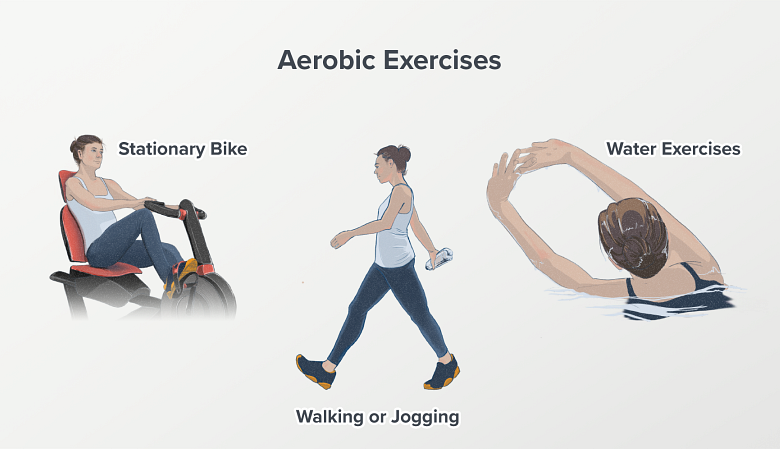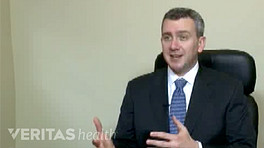Exercise can play a major role in relieving pain and other symptoms of fibromyalgia, but it must be approached carefully.
Aerobic exercise can be an important part of treating fibromyalgia.
Muscle, joint, and bone fatigue are common with fibromyalgia, which tends to discourage people from exercising. The lack of activity leads to deconditioning of muscles and further muscle pain and “fear of exercise” can become a vicious cycle further perpetuating the condition.
In This Article:
- Getting the Sleep You Need With Fibromyalgia
- Doctors Who Treat Fibromyalgia
- How Mind-Body Techniques Help With Fibromyalgia
- Exercise Helps Relieve Fibromyalgia Symptoms
Exercise can reverse this process by strengthening muscles, improving aerobic capacity, flexibility, and improving daily functioning. Additional advantages include, but are not limited to:
- Improved circulation
- Better quality sleep
- Enhanced mental outlook (less anxiety and depression)
- Weight loss
- Improvement in well-being and quality of life
See Getting the Sleep You Need With Fibromyalgia
At one time, it was thought that exercise would cause harm, and patients were discouraged from doing anything strenuous. Multiple studies since then have shown that exercise does not damage the body, and instead helps alleviate symptoms. 1 Busch AJ, Webber SC, Brachaniec M, et al. Exercise therapy for fibromyalgia. Curr Pain Headache Rep. 2011;15(5):358-67.
See Multi-Specialty Fibromyalgia Treatment
It is advised to consult with the doctor about the best level of exertion and what positions are safe before proceeding with any exercise regimen, however.
Exercise Without Overdoing It
Inactive individuals are likely to be more susceptible to muscle micro-trauma and worsening pain and stiffness when beginning a new exercise program. Because it usually takes about six weeks to see the benefits of exercise, there is a risk that the individual will give up on exercise too soon.
Taking these steps can increase the chances of success:
- Avoid a flare. If symptoms are flaring, wait until the flare is over before beginning an exercise program.
- Start gradually. A 5- to 10-minute warm-up and cool-down period of gentle stretching of the active muscle groups is needed to prevent unnecessary injury. That can be followed with 3 to 5 minutes of exercise, building up gradually over several weeks to 20 minutes of exercise per session.
- Add distance and repetitions slowly. Typically, fibromyalgia patients do not feel pain from exercise until the next day, so there is a risk of doing too much.
While some inactive people are likely to be sore after exercise, the pain should not be intense. Significant pain may be a sign that the exercise was excessive. In addition, failure to recover from the post-exercise soreness within 24-48 hours is another indicator to slow down the graduation process into more challenging exercises.
Exercising three to four times a week is recommended, but activity may need to be modified when symptoms flare. Exercising more than four times a week may increase the incidence of minor orthopedic trauma.
The range of symptoms and coexisting conditions common in fibromyalgia sometimes makes it challenging to find the right mix of exercises. Those having difficulty often find it helpful to meet with a physical therapist or an experienced exercise trainer. It is important to develop an individualized exercise program that emphasizes safe movements and the best frequency and intensity for maximum benefit.
See Arthritis Treatment Specialists
Variety of Exercises Helpful
Range-of-motion and low-impact aerobic exercises, such as walking, bicycling, using an elliptical machine, and swimming are good options for people with fibromyalgia. These exercises reduce the load on the musculoskeletal system and minimize the risk for undue joint trauma.
The medical literature has shown that the following exercises, often offered in group classes, can also be helpful in alleviating symptoms for a short or long period:
- Water exercises. The buoyancy and warmth of the water make this one of the most soothing, stress-reducing exercise options. These exercises are best done in a therapeutic pool, in which the water may be 86 degrees or warmer. People who find land-based exercises too painful may find water exercise more comfortable. 2 Segura-jiménez V, Carbonell-baeza A, Aparicio VA, et al. A warm water pool-based exercise program decreases immediate pain in female fibromyalgia patients: uncontrolled clinical trial. Int J Sports Med. 2013;34(7):600-5.
- Pilates. This low-impact strengthening and flexibility program features exercises done either on a machine or on a cushioned mat. The emphasis is on the body’s core—the abdominal, back, and pelvic floor muscles—which may also ease neck and back pain. 3 Altan L, Korkmaz N, Bingol U, Gunay B. Effect of pilates training on people with fibromyalgia syndrome: a pilot study. Arch Phys Med Rehabil. 2009;90(12):1983-8.
- Tai Chi. This traditional Chinese exercise features gentle, flowing movements in conjunction with meditation and controlled breathing. The movements build strength and flexibility and enhance balance. 4 Romero-zurita A, Carbonell-baeza A, Aparicio VA, Ruiz JR, Tercedor P, Delgado-fernández M. Effectiveness of a tai-chi training and detraining on functional capacity, symptomatology and psychological outcomes in women with fibromyalgia. Evid Based Complement Alternat Med. 2012;2012:614196.
- Yoga. Stretching, breathing, strengthening, and meditation are combined in this form of exercise. There are many different types, from beginning to advanced. 5 Mist SD, Firestone KA, Jones KD. Complementary and alternative exercise for fibromyalgia: a meta-analysis. J Pain Res. 2013;6:247-60.
Classes for these kinds of exercises are generally offered for all experience levels. Contacting the teacher in advance about which level would be best for the individual’s fitness level may be helpful. Some teachers will allow a person to observe the class before signing up.
Joining a supportive exercise class may have social as well as physical benefits, helping break the isolation people with fibromyalgia often experience.
If a class is not available or does not fit an individual’s schedule, check out the variety of exercise-related smartphone apps, online exercises, or DVDs. Many apps offer tips as well as videos showing a range of exercises, and a number of exercise videos are also online. Those who prefer DVDs may be able to check out a few for free at the library to see which one they want to purchase.
People who enjoy these exercises may want to try other fitness options. Research studies have indicated benefits from resistance training, 6 Busch AJ, Webber SC, Richards RS, et al. Resistance exercise training for fibromyalgia. Cochrane Database Syst Rev. 2013;(12):CD010884. such as weight-lifting, but this is best begun only after a regular routine of aerobic exercise has been established.
- 1 Busch AJ, Webber SC, Brachaniec M, et al. Exercise therapy for fibromyalgia. Curr Pain Headache Rep. 2011;15(5):358-67.
- 2 Segura-jiménez V, Carbonell-baeza A, Aparicio VA, et al. A warm water pool-based exercise program decreases immediate pain in female fibromyalgia patients: uncontrolled clinical trial. Int J Sports Med. 2013;34(7):600-5.
- 3 Altan L, Korkmaz N, Bingol U, Gunay B. Effect of pilates training on people with fibromyalgia syndrome: a pilot study. Arch Phys Med Rehabil. 2009;90(12):1983-8.
- 4 Romero-zurita A, Carbonell-baeza A, Aparicio VA, Ruiz JR, Tercedor P, Delgado-fernández M. Effectiveness of a tai-chi training and detraining on functional capacity, symptomatology and psychological outcomes in women with fibromyalgia. Evid Based Complement Alternat Med. 2012;2012:614196.
- 5 Mist SD, Firestone KA, Jones KD. Complementary and alternative exercise for fibromyalgia: a meta-analysis. J Pain Res. 2013;6:247-60.
- 6 Busch AJ, Webber SC, Richards RS, et al. Resistance exercise training for fibromyalgia. Cochrane Database Syst Rev. 2013;(12):CD010884.











